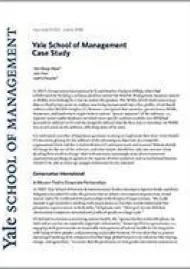Society: the Extended Environment of Business

“Society” is, for our purposes, a name for the extended environment of business. It is where managers find customers, employees, investors, savings that can become capital, and ideas. The sources of innovation vital to business sometimes lie within the firm itself; at least as often, they stem from other segments of society—university researchers, amateur tinkerers, customers making suggestions, and attendees at trade-association conferences. Society is also where firms encounter competitors, shifting technologies, drifting cultures of consumption, and shifting attitudes toward work. In this memo, we survey one of the societal elements that matters most to business management: people.
People have always mattered to business, and individuals who have developed relevant forms of talent will always be critical to managerial success. As one recent IBM analysis reports:
For companies operating in mature economies, changing workforce demographics are making it difficult to both retain critical knowledge from older workers and attract new employees from increasingly smaller labor pools. In emerging markets, we are seeing the combination of rapid corporate growth and a limited number of experienced workers resulting in wage escalation and higher turnover. Therefore, in both segments of the world economy, finding, developing and holding onto individuals with the right capabilities is becoming a critical capacity.
We often assume that the pinch in access to productive employees falls at the high-tech end of the spectrum, but quite often it develops around specific skill sets of a less technical kind. For instance,
TRAFFORD, Pennsylvania (Reuters) - Only half the machines are running at precision parts maker Hamill Manufacturing, nestled in the Allegheny Mountains just east of Pittsburgh, once the booming center of the U.S. steel industry.
But the factory's overcapacity is the result not of a shortage of business - it has more orders than it can fill, despite a slowing U.S. economy - but because of a shortage of skilled workers.
"I'd hire 10 machinists right now if I could," said John Dalrymple, president of the company, which makes high-end parts for military helicopters and nuclear submarines. "That's eight to 10 percent of our workforce."
While millions of jobs making everything from textiles to steel have moved to new powerhouses like China in recent years, precision manufacturing remains a crucial niche in the United States, one that is overworked and chronically understaffed.
And, in a bad sign for the United States and its declining economic might, that shortage of skilled workers is likely to get worse as Baby Boomers retire - with no younger generation of manufacturing workers to take the baton." Our workforce is an aging workforce,” said Chief Executive Jeff Kelly, whose father founded Hamill nearly 60 years ago. “There isn't a queue of people lining up to come into the industry.”
Some 20 percent of small to medium-sized manufacturers -- those with up to 2,000 workers -- cited retaining or training employees as their No. 1 concern, according to a survey by the National Association of Manufacturers. The survey was carried out in 2007 but has not been published yet.
Three dimensions of society converge in the search for good employee talent: demography, culture, and human capital. Demography concerns the biology of birth and death over time, yielding various distributions of age cohorts, from which talent useful to business may (or may not) be drawn. Think of demography as the supply chain of human abilities, which are then developed, or wasted, by society.
The second dimension is culture—the embedded norms, symbols, myths, and aspirations that define the society and its segments. Some aspects of culture will run through an entire society while others (subcultures) are limited to specific segments of a society. On the broad or macro side of culture, long historical forces are at work—as with the traditions of world religions, such as Christianity, Islam, Hinduism, Confucianism, Buddhism, and Judaism. For management, religious conviction comes into play most directly as it impacts attitudes toward work and consumption. But many other cultural dimensions also matter to the broad environment of business, including the capacity for trust beyond the family, the legitimacy of interest on capital, the rights of women, openness to innovation, and tolerance for difference of style and belief.
Management, by the way, is far from neutral among cultures: It is committed to a series of norms based on transparency, efficient use of scarce resources, rational planning, and openness to talent across races, religions, and genders. Trained management, in other words, has a subculture of its own—just as do other learned professions such as medicine and law. While this subculture coexists happily with many broad cultural traditions, it is sometimes in tension with those traditions.
Demography supplies humans, culture shapes them, and education broadly understood develops them. The name for developed talent is human capital. This is the third social dimension. Chicago economist Gary Becker sums up the concept thus:
To most people capital means a bank account, a hundred shares of IBM stock, assembly lines, or steel plants in the Chicago area. These are all forms of capital in the sense that they are assets that yield income and other useful outputs over long periods of time. But these tangible forms of capital are not the only ones. Schooling, a computer-training course, expenditures of medical care, and lectures on the virtues of punctuality and honesty also are capital. That is because they raise earnings, improve health, or add to a person's good habits over much of his lifetime. Therefore, economists regard expenditures on education, training, medical care, and so on as investments in human capital. They are called human capital because people cannot be separated from their knowledge, skills, health, or values in the way they can be separated from their financial and physical assets. Education and training are the most important investments in human capital.